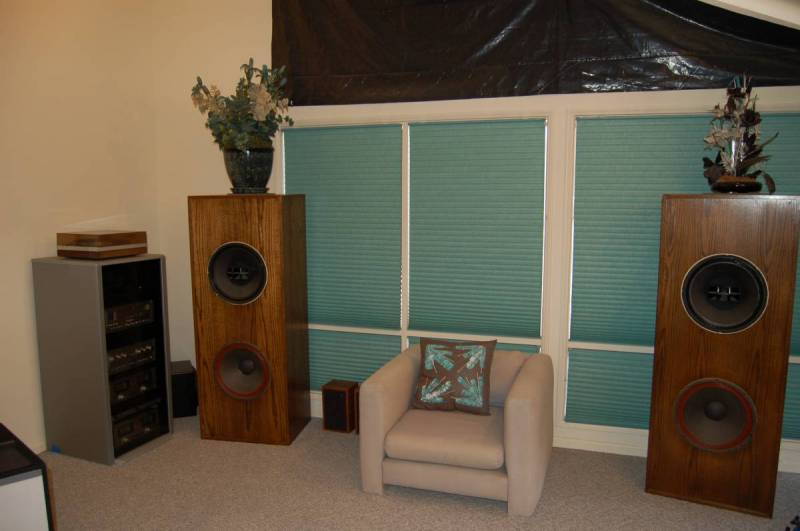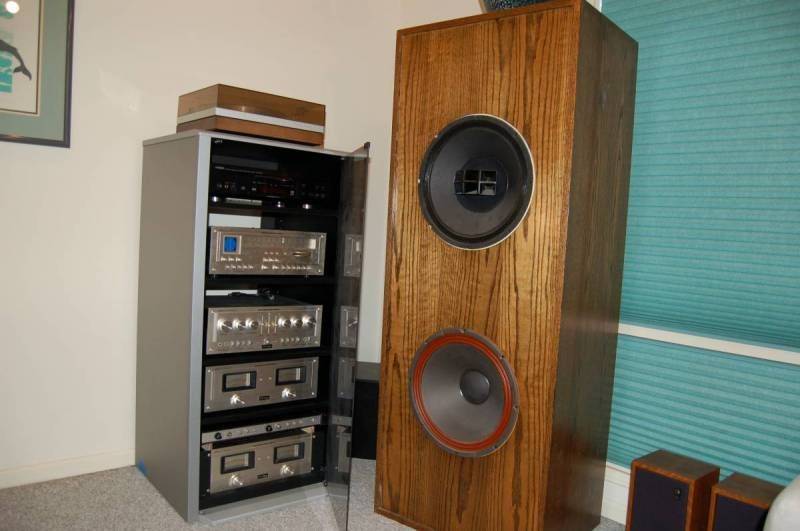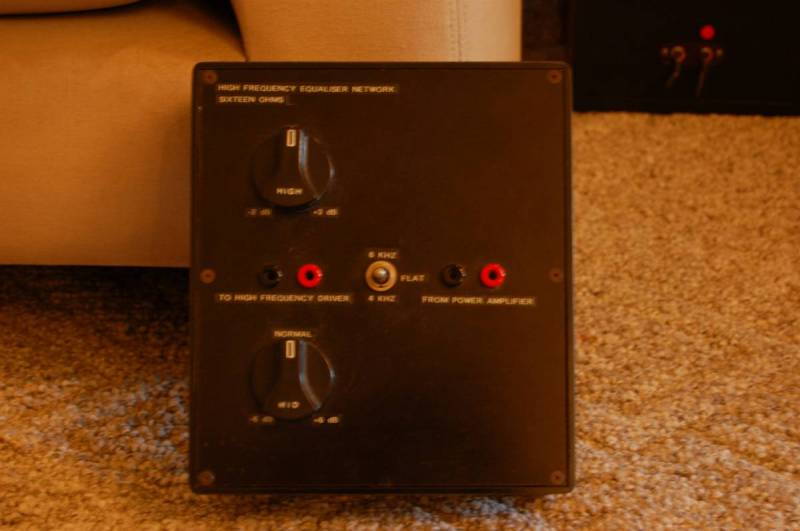My gear is Bryson B135 SST2 Integrated Amp with respectable onboard DAC (see Mike Lavorgna of Twittering Machines comments), Auralic Aries Dual Femto streamer connected to integrated with Shunyata Theta digital cable, Martin Logan Montage with Transparent Music Link Plus speaker cable. The integrated has a tape loop where I connect a Charter Oak PEQ-1 studio analog EQ via Cardas Clear Sky ‘round trip’ cabling. I cut that loop in and out to taste and mood and depending upon the material listened to by simply toggling the monitor button on the Bryston remote from the listening position.
Thanks.
Does anyone own a tri amped system in Florida I could hear?
That is my query. I have an audiophile friend in Australia who swears by this approach, and I am wondering just how many levels up one can go in SQ as well as full extension tone in doing this. I am a very happy balanced analog EQer for tone but want to experience everything.
Thanks! Sorry I don’t have my system posted still but I’ll put it in the next box here.
There are so many variables involved, that it’ll be tough to distinguish which contributions are specifically from tri-amping. |
I agree with @knotscott concerning the variables, and not to diminish your system in any way (it seems to be very nice), but at your level it seems that triamping would be a little over the top, and more trouble than it's worth. |
@knotscott +1 @tlcocks How would you know if the "wow moment" is due to tri amping and not due to all and every component, and the room. Chances that there is a mirror image of your system somewhere are pretty much nonexistant. |
Of course you are right. And I wouldn’t really know. But I still want to hear a properly tuned tri amped system to see how it compares to analog balanced equalized sound. Which is all I listen to and is still preferable to me to just about every other system I’ve heard. But my listening experience is primarily show room set ups, even very pricey ones like d’Agostino monos driving Wilsons. I’ll bet I can hear better constructed systems in the homes and listening rooms of you thoughtful serious hobbyists. Ones with personalized attention to cable looms, mods etc. if such an individual had a well put together triamped system I’d simply love to hear it. |
On paper, bi-amping or tri-amping can give you more control and potentially better dynamics on some ultra-high end speakers but in practice the payoff is often marginal compared to the cost, complexity, and space it demands. A well-designed single amp driving a well-matched pair of speakers is usually simpler, more musical, and easier to live with. And don’t overlook, the heat generated by more amps in the system, after all you live in Florida :-) And yes, I have tri-amped and bi-amped setups in the past. Won’t do it anymore since switching to an Integrated with class A watts. |
@jallan +1 There is a dealer in Miami. Thanks! Is anyone out there actually tri amping and loving it? Love to hear from you! |
@lalitk +1 super valuable feedback. Thanks! |
Hi, first I would like to say that I am in the audio industry but I'm commenting on tri-amping a system and not selling anything. I am currently fully electronic and I am tri-amping my system. For me the advantages are many. If you look at a passive crossover and you look at the tolerance levels for each component in the passive crossover, each component has a tolerance level of approximately 5%. If the average passive crossover has 10 components then this means that the sound from the left to the right speaker can be very different by a large margin. If you use a very high quality processor/electronic crossover that crosses over each of the six drivers individually and then the processor puts all the drivers in correct phase, then there is literally no phase issues and the sound from each driver/speaker arrives at the same time to each of your ears. I'm not saying that all passive speakers sound bad but I am saying that if the electronic processor has a very high quality external mic system and you can mic your room as will as electronically crossover your speakers over then it's going to be difficult to get a passive crossover that can remotely mimic all these variables. Yes you need extra cables and yes you need extra amplifiers for the six channels of amplification. But in the end you do have much more control over your room acoustics and you are receiving a more accurate representation of the original recording. It also makes your speakers much more efficient. These are just my opinions and again I'm not trying to sell anything but rather just giving my opinion based on many years of trying passive versus fully electronic. Cheers Robert Neill. |
With bryston it has on model t and electronic crossover and you can tri amp it.many big speakers let you tri amp.sublime acoustics h electronic crossover has a gain know that let's you match the volumn of each amp.dbx ,mini dsp,and old yamaha have electronic crossovers you can program. Mcintosh xrt 2k tri amp.i have tekton ulfbrich I tri amp.my infinity rs 1 b are tri amped as well as irs v.my vmps rm 40 is triamped. It allows you to run 1 or 2 kw amps to the base and less to mids and even less to the tweets then you dsp sound levels and make the graph flat.there is even a simple cell phone app that measures the frequencies. And make sure no peaks or trough.electronic crossover dsp and triamp is the next level up in audio.madisound and parts express have all the stuff for you to build.enjoy the hunt. Klipsch just put electronic crossover on some of thier speakers.you have to wounder why more manufactures are doing this electronic crossover..my legacy valor has a electronic 3 way crossover the wavelet. |
My system is tri-amped and I wouldn't have it any other way. It is a worthy pursuit. I use four Pass Labs amps, 2 X260.8 mono-bloc amps for the woofers, and one each XA30.8 for the mids and the tweets. The amps never get out of class A no matter how loud I make it or how high a peak demand may be. I believe the biggest advantage is that the mids/tweets have no idea what the woofers are doing. Yes the run a little hot, about 107 F. An ARC Ref6 goes into a custom Marchand electronic x-over and out to the amps. Marchand has you pick the slopes and x-over points. They can be changed by ordering small pc board plug-in modules. The front panel has level control for bass/mids/highs for each channel. Very handy. Fun to fiddle with for a while, then I've found what I like and "usually" don't touch it anymore. The source is all digital and the speakers are Hartley Reference (no longer available). I haven't been everywhere but I have not heard anything better. Its out there but I have ceased to look for it. This is my end-game system. Regards, barts |
| Post removed |
Awesome guys. Lots to chew on here. Thanks! @barts , what state you live in? Assuming once we communicated more you’d give a brethren audiophile a listen. I also intend to call that North Miami store. |
I have been bi-amping for many years. Moved to tri-amping, not quite a year and a half ago. Results far exceeded my expectations. I'm not in Florida, though I will be for a couple of weeks in November, but if you are ever traveling to the bold north for business or pleasure, you are welcome to contact me. I am about 15 minutes from a major airport. |
I have a biamp set up. Not sure why you’d want to go full scale tri amp. Absolutely too many wires and interconnects to deal with and then the crossover machinery is very difficult to figure out which one to buy and there aren’t too many examples out there people doing this that I could find. Further if you’re going to do tri or biamping, I would think you’d want to get a tube amplifier involved to deal with the upper drivers because that’s better for the harmonics and the solid state amplifier could handle the bass drivers. And this is the best of all possible worlds.
|
@emergingsoul +1 Unless you have and infinite budget. Each additional piece of equipment reduces the overall investment level of each amp, interconnect, and power cord. Also, introduces possible differences in character of the sound in the system... so, could influence coherence, The way I think about it if I had the choice between buying 3 $2K amps and on $6K amp... the choice is simple the sound quality of a $6K or $12K or more amp is going to be much better (assuming you choose wisely). If the choice is between one $6K amp or 3 $6K amps... but then a single $18K amp will sound better... .this is why I just can't logically get there. Listening to one... now that is a great idea. |
My Buddy in Australia is particular about his treble. As I am also. That’s why he tri amped. I do understand there are great complexities with amp choices, crossover choices and cable choices. If I do get to hear a system, I have to hope it’s set up well. That Klipsch video was nice! Sounded superb even via YouTube. Even iPhone speaker,lol! |
What speakers are you using that will allow Tri amp. I know Sonos Faber lilium speakers do it, and they are tempting but my room is too small and the bass drivers would overwhelm the place. Are u planning to remove the internal crossovers? I guess that would be pure triamp. Otherwise you'll be competing with what's going on inside the speaker but that may be OK. I really think you need to try biamping. I doubt many people in this universe are triamping, and if so you'll probably never find them to see them in person. I would like to personally visit a triamp Domain as the systems are extremely technical and well thought out if done well. A true connoisseur. |
If you find your self in the NYC metro area it could be possible to set something up. "Unless you have and infinite budget. Each additional piece of equipment reduces the overall investment level of each amp, interconnect, and power cord. Also, introduces possible differences in character of the sound in the system... so, could influence coherence" The bass mono-blocs ~$16,000 and the mids/highs ~$8,000 each, so call it ~$32,000 all in. I wouldn't think that sounds ridiculous to a guy who has stated that he has $150,000 into his system. BTW the ARC REF6 and Pass amps are a match made in heaven. Tubes and class A amps, yeah baby yeah! Regards, barts
|
@barts , sounds good. Thanks! |
I rarely listen to my tri-amped set-up, partially because of the seating logistics. Mine is vintage (Super Big Reds) with Marantz amps, and I prefer the Mermans that I created (JBL 18", JBL 10", Heil AMT) with passive crossovers. But then, I designed these in the room in which they are used and am extremely careful in how I match parts in the crossovers, of my own design. The tri-amped setup uses the Super Big Reds (Altec 604E2/Utah aux woofer) that I purchased from a recording studio. These are one-off in furniture-grade oak cabinets. The analog electronic crossover was designed for this assemblage and is also a one-off. There are also passive eq units that go between the amp and the horn drivers. The amps include two Marantz 170DCs for the four woofers and a Marantz 1180DC integrated for the preamp and to power the horn drivers. I also have the matching Marantz 2130 tuner with the built-in O-scope. This set-up could be had..., but I am on the left coast. I was trying to track their history, but Doug Sax had died a couple years prior to when I got them.
|
@tlcocks -- It depends on the approach you want to pursue: with passive bi-amping I don’t see the obvious benefits to make it worthwhile and would rather invest the money on a single amp. However, if you want to see how deep the rabbit hole really goes, so to speak, go outboard active - which is bi-, tri- etc.-amping by its very nature and inherent to its design. This is where the real benefits of such an amp configuration will show itself, and contrary to passive bi-amping it’s a dedicated approach that 1) sees the negation of the passive crossover between the amps and drivers for direct connection between a single amp channel and its driver section, and 2) that each amp channel will only be asked to amplify a frequency limited range - as dictated by the digital crossover/DSP or electronic crossover (analogue) and the line signal received here. That means load independency between the different driver sections, much easier amp load and better driver control. Moreover, if you go outboard active with the subs to boot (that is, no built-in so-so plate amps and DSP), you’ll get to experience the importance the amplifier has in the lowest octaves as well, and it also means you can now use the same topology/brand amp over the subs as the ones used in the remaining frequency range above for even better coherency and overall sound quality. It’s what I do; active tri-amping with the same topology/brand amps top to bottom. Who said anything about "easier" or "convenience"? It’s the results that matter, right? Fortunately active bi/tri/more amping equates into much more efficient use of an amplifier’s performance and power envelope, meaning you can do with less one way and the other and still get great results - effectively rendering the "infinite budget"-claim moot. Indeed on the contrary; active configuration can save you money eventually, and it’s not like audiophiles are necessarily money shy to begin with. |
| Post removed |
Very cool! As far as same amps for each of the lows/mids/highs for the sake of coherence, that does make sense. My buddy’s approach is a bit different, with different flavors of amp for each, based on his sonic preferences. Similarly, different cables for same reasons. He however has access to the gear and has devoted endless attention to trial and error. He’s got it tuned and loves his results so far. It has to be very tricky though. With different amp sensitivity, etc. Aside, is it best to do all this with DSP or analog active Xover? My friend uses a K231 by Sublime. Analog. Says it’s the best. |
The best place to do the experiment would be a high end dealer that would have the patience to work with the OP. Such stores are of course hard to find, but given the amount of money that is concentrated in the state of Florida, there has to be one somewhere. Has the OP tried Sarasota, Naples, or Miami, just for starters? |
| Post removed |
Very very interesting. @mijostyn , are you out there to comment? |






